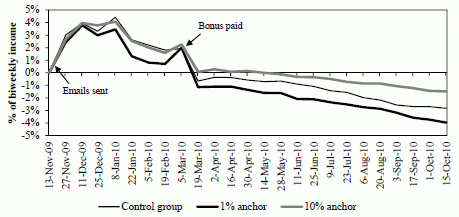There is widespread concern that individuals do not save enough for retirement because they are financially illiterate (Lusardi and Mitchell 2007, Bucher-Koenen and Lusardi 2011) or suffer from self-control problems (Angeletos et al 2001). This concern has motivated policymakers and organisations to implement policies that promote higher savings. Traditionally, these policies have focused on using economic levers such as tax incentives and employer-based subsidies for saving.
In recent years, considerable attention has turned to the use of psychological levers instead to influence savings. Thaler and Sunstein (2003) coined the term ‘libertarian paternalism’ to describe a set of interventions that influence choices through psychological channels while not restricting choices. Such interventions have also been called 'nudges' (Thaler and Sunstein 2008, Calzolari and Nardotto 2011, Costa and Kahn 2010).The most commonly implemented libertarian paternalistic policies are automatic enrolment and automatic contribution escalation, which respectively enrol you in or increase your contribution rate over time in a retirement savings plan unless you opt out. These policies have large effects on savings outcomes (Madrian and Shea 2001, Choi et al 2002, Thaler and Benartzi 2004).
Automatic enrolment and automatic escalation change the default outcome, harnessing individuals’ inertia. But defaults are not a panacea. From a practical perspective, it is not possible to implement outcomes by default in every setting.
In this column, we describe a set of libertarian paternalistic treatments that use subtle savings cues in emails to affect active savings decisions. These cues can change contributions to retirement savings accounts by up to 2.9% of income – an order of magnitude larger than the effects Kusko et al (1998) and Choi et al (2002) estimated at two other companies that introduced expensive subsidies for contributing to these accounts.1
Three psychological mechanisms
In recent research (Choi et al 2012), we analyse a randomised field experiment run at a large US technology company. The treatments tested attempted to harness three psychological mechanisms:
- Anchoring. The presentation of arbitrary numerical cues, or ‘anchors’, can shift subjects’ judgements and willingness to pay for goods towards those anchors (Tversky and Kahneman 1974, Ariely et al 2003).
- Goals. Setting concrete goals that are difficult to achieve enhances performance relative to setting unambitious or vague “do your best” goals (Locke and Latham 1990). Behaviour changes even when the goals are only subconsciously made salient by environmental cues (Chartrand and Bargh 1996, Bargh et al 2001, Stajkovic et al 2006).
- Savings thresholds. Many people simplify the problem of choosing a savings rate by contributing up to a salient savings threshold created by their retirement savings plan’s structure, such as the maximum possible contribution or the threshold at which contributions are no longer subsidised by the employer (Choi et al 2002, Benartzi and Thaler 2007). Making one of these thresholds more salient may cause choices to shift towards that threshold.
The prediction from prior literature is that presenting higher savings anchors, goals, or thresholds will result in higher subsequent savings rates than presenting lower savings cues. On the other hand, it was possible that higher cues would discourage employees, resulting in lower subsequent savings rates.
The retirement savings plan setting
Employees at this company are eligible to contribute to a 401(k) plan, which is a defined contribution retirement savings plan sponsored by the company. Employees can choose to have a percentage of their salary deducted from each paycheque and contributed to the savings plan. The contribution rate can be changed at any time, but ordinarily remains constant from paycheque to paycheque unless the employee actively changes it. The company subsidises employee contributions by making matching contributions to the plan.
The savings cues
Employees were randomly assigned to receive one of several different emails reminding them about the match in their retirement savings plan. All emails were identical except that treatment emails had one to two additional sentences that provided a savings cue, as shown in Table 1. Control emails did not have this cue text.
Table 1.
Effect of the cues
The control email alone has a large effect on contributions. As Figure 1 shows, eight weeks after the email was sent, the average contribution rate of control email recipients is 4.4% of income higher than what it was immediately prior to the email. But this effect dies away 16 weeks after the email when the annual bonus is paid on 5 March.
Turning to the treatment emails, we consistently find that employees who received high saving cues subsequently contribute more to their retirement savings plan than employees who received low savings cues. For example, the graph below shows that receiving the 1% anchor depresses contribution rates by up to 1.4% of income prior to the 5 March bonus payday, and by up to 1.2% of income after the 5 March bonus payday. Receiving the 10% anchor had no effect prior to the bonus payday, but increases contribution rates by up to 1.0% of income after the bonus payday. These effects are large and persist for nearly a year after the emails were sent.
Figure 1. Average contribution to savings plan in excess of contribution rate prior to 17 November 2009 email
Similarly, receiving an $11,000 goal example raises contribution rates by up to 2.2% of income relative to the control group, whereas the $7,000 goal example has no effect. Highlighting the $16,500 savings threshold raises contributions by up to 1.5% of income relative to highlighting the $3,000 savings threshold. And highlighting the maximum possible contribution rate raises contribution rates by up to 2.9% of income relative to the control group, but only among those who were contributing little to the plan before the email.
Conclusion
The fact that small cues have such a large effect on savings choices raises doubts about how closely financial choices correspond to fundamental preferences for the typical person. Our findings provide both an opportunity and a warning for organisations and policymakers. The kinds of cues we investigate could be intentionally used to influence saving behaviour more efficiently than through the use of more costly interventions, such as financial education or increases in matching incentives. But unintentional cues buried in mundane communications can also affect behaviour. Thus, organisations and policymakers should take responsibility for the cues they disseminate and wield them mindfully.
References
Ariely, D, G Loewenstein, and D Prelec (2003), “Coherent arbitrariness: Stable demand curves without stable preferences”, Quarterly Journal of Economics 118, 73–105.
Angeletos, George-Marios, David Laibson, Andrea Repetto, Jeremy Tobacman, and Stephen Weinberg (2001), “The hyperbolic consumption model: Calibration, simulation, and empirical evaluation”, Journal of Economic Perspectives, 15:47–68.
Bargh, J A, and T L Chartrand (1999), “The unbearable automaticity of being”, American Psychologist 54: 462–79.
Bargh, J A, PM Gollwitzer, A Lee-Chai, K Barndollar, and R Troetschel (2001), “The automated will: Nonconscious activation and pursuit of behavioral goals”, Journal of Personality and Social Psychology 81:1014–1027.
Benartzi, Shlomo, and Richard Thaler (2007), "Heuristics and Biases in Retirement Savings Behavior", Journal of Economic Perspectives 21(3): 81–104.
Choi, James J, David Laibson, Brigitte C Madrian, and Andrew Metrick (2002), “Defined contribution pensions: Plan rules, participant decisions, and the path of least resistance”, in James Poterba (ed.), Tax Policy and the Economy, 16:67–114.
Kusko, Andrea, James Poterba, and David Wilcox (1998), “Employee decisions with respect to 401(k) plans”, in Olivia Mitchell and Sylvester Schieber (eds), Living with Defined Contribution Pensions: Remaking Responsibility for Retirement, University of Pennsylvania Press.
Locke, Edwin A, and Gary P Latham (1990), A theory of goal setting & task performance, Englewood Cliffs, NJ: Prentice Hall.
Lusardi, Annamaria and Olivia S Mitchell (2007), “Baby Boomer retirement security: The roles of planning, financial literacy, and housing wealth”, Journal of Monetary Economics, 54:205–24.
Madrian, Brigitte C and Dennis F Shea (2001), “The power of suggestion: Inertia in 401(k) participation and savings behavior”, Quarterly Journal of Economics, 116:1149–87.
Stajkovic, A D, E A Locke, and E S Blair (2006), “ A first examination of the relationships between primed subconscious goals, assigned conscious goals, and task performance”, Journal of Applied Psychology 91(5): 1171–80.
Thaler, Richard H and Shlomo Benartzi (2004), “Save More Tomorrow™: Using behavioral economics to increase employee saving”, Journal of Political Economy, 112:S164–S187.
Thaler, Richard H and Cass R Sunstein (2003). “Libertarian paternalism”, American Economic Review 93: 175–79.
Thaler, Richard H., and Cass R. Sunstein (2008), Nudge: Improving Decisions About Health, Wealth, and Happiness, Yale University Press.
Tversky, Amos and Daniel Kahneman (1974), “Judgment under Uncertainty: Heuristics and Biases”, Science, New Series, 185(4157) 27 September: 1124–31.
1 The subsidy changes studied by Kusko et al (1998) and Choi et al (2002) were probably accompanied by communications that contained savings cues, but these communications may not have been very salient and the cues not designed to trigger known psychological mechanisms.









